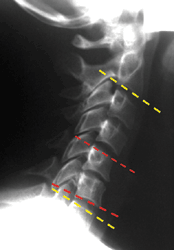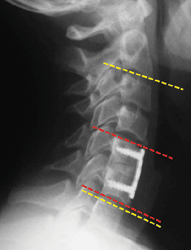No correlation between better post-ACDF sagittal alignment and quality of life results
ORLANDO, Fla. — At 2 years minimum follow-up, whether or not cervical sagittal alignment after anterior cervical disc fusion was maintained or restored had no bearing on patients’ radiographic measures or clinical outcomes scores in a retrospective study conducted at the University of Louisville.
Among the 101 patients included in the investigation — 75 women, 26 men, mean age 52 years — both overall lordosis and segmental lordosis increased after anterior cervical decompression and fusion (ACDF), but not significantly, resident Jeffrey L. Gum, MD, noted in a podium presentation at the 2010 Annual Meeting of the North American Spine Society, here. However, “There was a statistically significant increase in all outcome measures” used, which were the Neck Disability Index (NDI), the SF-36 Physical Composite Summary and numeric arm and neck pain scale scores, he said.
Furthermore, “There was no significant correlation between sagittal alignment and Health Related Quality of Life measures,” Gum said.
Alignment on radiographs
To measure cervical spine sagittal alignment, Gum and colleagues applied the Cobb method to upright lateral radiographs of each of the patients before surgery and at 2 years after in order to rate their overall lordosis or kyphosis following ACDF. In addition, they assessed the patients’ Health Related Quality of Life (HRQoL) measures at those same intervals.
|
|
Images: Norton Leatherman Spine Center |
Gum noted the most common operative indications in the study group were spondylosis, herniated discs and nonunions, which accounted for the need for surgery in 70 patients. One-quarter of the patients were smokers, he added.
Summing up the overall alignment results, preoperative lordosis of 6.7° increased to 7.7° at 2 years after ACDF with an increase in segmental lordosis from 0.9° to 2.2° at the same follow-up. The NDI scores improved from 27.5 to 21.7 points, while the neck and arm pain scores improved from 7.4 to 5.1 and 6.2 to 4.1 points respectively.
Correlations studied
The Spearman correlation coefficient that investigators calculated for the difference between the patients’ radiographic and outcome variables did not show a significant relationship between them, Gum noted.
Results of the receiver operating characteristic (ROC) curve constructed as part of the study found that achieving 6° of lordosis to be fairly predictive of minimum clinically important differences in NDI, he said.
During the discussion period, Steven D. Glassman, MD, Gum’s co-investigator, said the researchers had hoped to also examine global sagittal alignment on radiographs and compare that to clinical outcomes. However, radiographic landmarks in the cervical spine are difficult to delineate on long radiographs. – by Susan M. Rapp
Reference:
- Gum JL, Glassman SD, Douglas LR, Carreon LY. Correlation between cervical spine sagittal alignment and clinical outcomes after ACDF. Paper #4. Presented at the 2010 Annual Meeting of the North American Spine Society. Oct. 5-9, 2010. Orlando, Fla.
- Jeffrey L. Gum, MD, can be reached at Department of Orthopaedic Surgery, University of Louisville School of Medicine, 210 East Gray St., Suite 1003, Louisville, KY 40202; 502-584-7525; e-mail: jlgum001@gmail.com. He has no direct financial interest in any products or companies mentioned in this article.
The authors of this study have performed a retrospective analysis of the effects of segmental and overall cervical lordosis following an ACDF on NDI scores and other patient reported HRQoLs. The authors found that there was no statistical significant correlation between a patient’s cervical sagittal alignment and HRQoL, but there was a correlation between overall cervical lordosis of at least 6° and a fairly predictive achievement of the minimally clinical important difference for the NDI.
This paper investigates the correlation between cervical sagittal balance and a patient’s outcome following an anterior cervical decompressive and grafting procedure. It is the resounding consensus that global spinal balance following reconstructive spinal surgery predicatively releases stress on the surrounding bony ligamentous and muscular structures. The authors have attempted to validate this assumption using spinal imaging localized to the cervical spine. Interestingly there was no statistical significant change in the sagittal alignment between preoperative and postoperative measurements which may suggest that anterior plating may not significantly prevent graft subsidence assuming localized lordosis is improved at the time of surgery. In addition the authors could not correlate cervical sagittal alignment with patient-related outcomes. They did find however that if overall cervical lordosis was 6° or greater then one would achieve the minimally clinical important difference for NDI. This paper therefore supports the contention that lordosis is good in the cervical spine and one should strive to achieve this during surgery. We may find out that with full-length films, overall global sagittal balance may translate into significantly improved clinical outcomes.
– Alexander R. Vaccaro, MD, PhD
North
American Spine Society session moderator
Professor of Orthopedic Surgery
and Neurosurgery
Thomas Jefferson University
Philadelphia
![]()
Alexander R. Vaccaro, MD, PhD has no direct financial
interest in any products or companies mentioned in this article.
![]() Follow
OrthoSuperSite.com on Twitter
Follow
OrthoSuperSite.com on Twitter


